1. The lab was no longer paying for my train ticket and per diem.
2. I no longer had to work in Munich, thus extending our holiday vacation virtually a full week.
In my opinion, the trade-off was totally worth it.
After our sledding excursion on Saturday (which was so special that it merits a separate post), Franz and Doro took us around the city on Sunday. We saw the beautiful tower of the Rathaus (city hall, for those who have forgotten), pictured here.

Since its construction in 1908, the Glockenspiel on the tower has delighted audiences at least daily with a 12-15 minute mechanical dance/presentation the represents two stories from the 16th century. First (on the top deck) is a depiction of Duke Wilhelm V's marriage to Renata of Lorraine (1568). There is a life-sized jousting match in honor of the newlyweds, pitting Bavaria against Lothringen. Guess who wins?
The bottom deck shows the Schäfflerstanz (the coopers' dance). From Wikipedia:

We have some short movies of the Rathausglockenspiel in action here and here.
Munich was an astoundingly beautiful city. There were abundant stair-stepped roofs:

Those roofs were even more apparent from the aerial view afforded by Alter Peter's church tower:
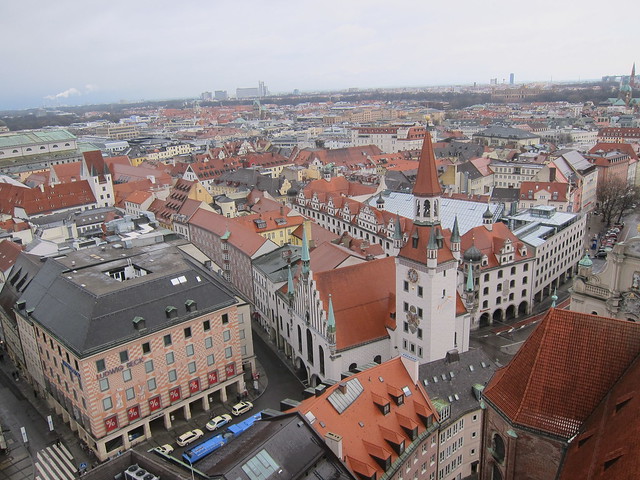
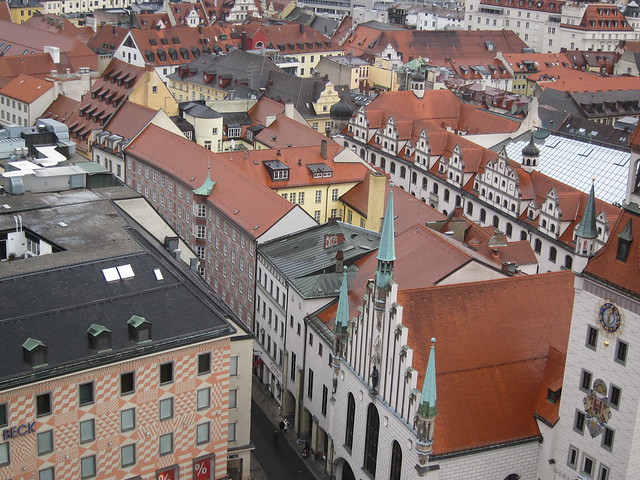
Here you see tour guide Franz giving Sara a church-tower-by-church-tower description of the city, with Doro in the red hat offering backup.

I think this may be one of the best pictures I've ever taken: the Münchener Rathausturm (city hall tower in Munich) in front of the red-roofed cityscape. The yellow church in the middle of the picture is the Theatine Church, built in the late 17th century in a beautiful high-Baroque style with a facade completed nearly 100 years later in a Rococo style. Both the outside and inside of this church were amazing.

A highlight of any visit to Munich (apparently) includes a trip to one of the Brauhäuser, the brewery-houses that dot the city. Franz and Doro took us to the Hofbräuhaus, a state-owned (!) brewery founded by our very own and recently married Duke Wilhelm V (1568). These brewery-houses are really cool: they have huge open areas with tables for people to gather, dance, sing, play music, play cards (and possibly other games). Some tables occasionally get reserved for community groups, and all tables get covered in beer. Hofbräuhaus has a section in the front for the Steine (giant beer mugs) for all of the famous people in Munich. If you're a mayor or other dignitary, you get your own Stein-storage locker at the Haus. Sara, Franz, and Doro have already picked out their spots (there weren't many empty ones left).
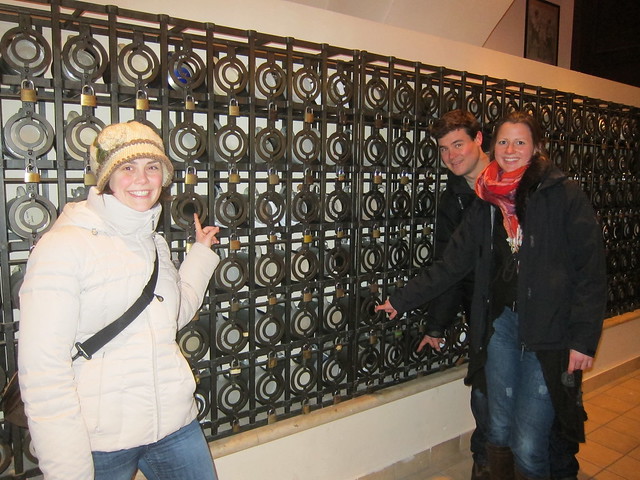
At the Hofbräuhaus, Sara and I both got one of our very favorite German foods: Käsespätzle. I won't describe it in too much detail here (since we don't have any trips planned and we need to save material for future blog posts), but it's like macaroni and cheese with extra deliciousness. And crispy onions. It's amazing. Also, I had my second non-alcoholic beer in a month! After reading my vivid description of my last near-beer experience, you're probably wondering why? Basically, Bavaria is the home of good beer, Franz knows good food, and after I told him that I had a near-beer in Köln, he told me that of course is tasted awful--it IS awful! Of course the WEIßbier is much better, even refreshing like a light, sparkling apple juice. Well, Franz, you are right. The Weißbier is MUCH better than the beer in Köln, no questions. Perhaps even a hint of sparkling apple juice is detectable. However, it's still just not that good. So, after two near-beers from the land of beer, I can conclusively say that I just don't like non-alcoholic beer. And, not drinking the other variety, beer just isn't going to play a role in my life. But I had the experience. Twice. Which was exactly two time more than I really needed, I suppose.
Another must-see in Munich, which we saw on Monday, is the Residenz, the former royal palace of Bavarian monarchs (construction begun in 1385, actively used as a palace from 1508, and converted to a public museum in 1918). Don't let the name "Residenz" fool you: this wasn't just a regular place for living, this is the largest castle-palace-museum-treasury conglomeration I've ever seen. It was labyrinthine and gargantuan and awesome. We started in the Schatzkammer (treasury) for some really gorgeous relics, and we'd now like to present a few exhibits, including this small selection of royal crowns:
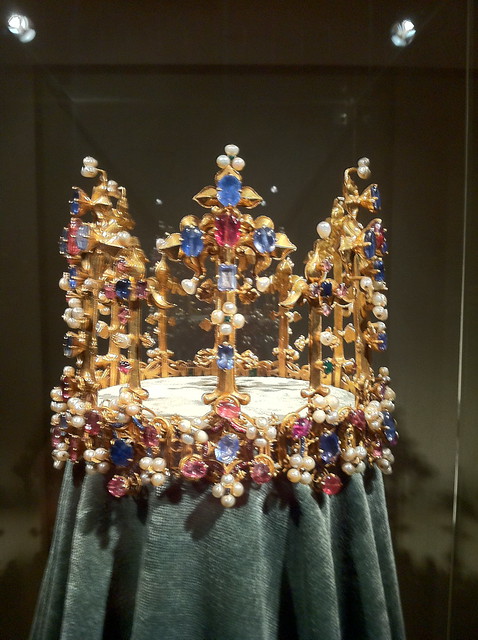
(The pearly one is for Julia.)
Next, we have a travel kit of Marie Louise of Austria, the second wife of Napoleon. It includes service for four, travel toiletries, writing and seeing kits, several secret compartments, a measuring rod, a screwdriver, and implements for basic dental work.
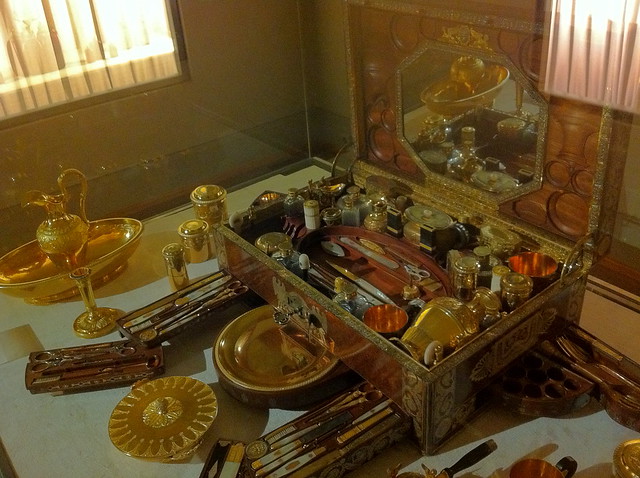
Not in the treasury, this room in the Residenz palace appears to be decorated entirely in seashells.

These three final photos show some of the more breathtaking rooms of the Residenz. The first is the largest Renaissance interior north of the Alps, an room for antiques belonging to Duke Albrecht V. It is 66 meters (over 216 feet) long and full of elaborate busts and paintings.
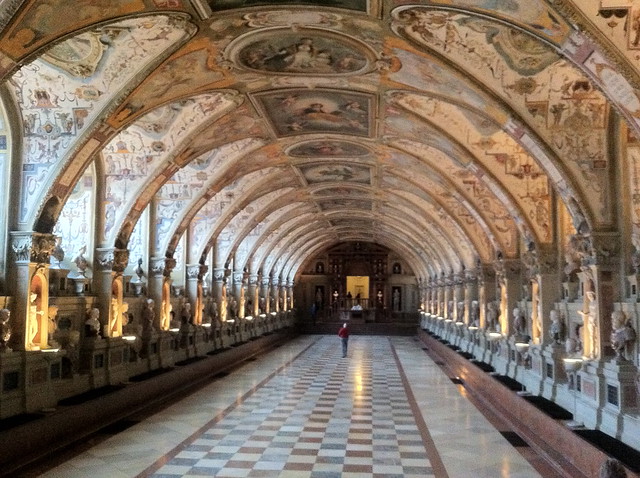
Next is the private chapel of Duke Maximilian I, the Ornate Chapel. The title says it all. (The photo captures some of the ceiling and the porcelain cabinet on one of the walls.)

Lastly, a room for the family history aficionados, the Ancestral Gallery, full of over 100 portraits of members of the Wittelsbach family. Apparently, Karl Albrecht (in 1726) was hoping to curry favor with important people by demonstrating how well connected his family, and consequently he, had become by marriage. His plan worked: in 1742 in Frankfurt he was crowned Emperor Karl VII of the Holy Roman Empire. Do your family history, kids.

Munich is a beautiful city, one that we hope to revisit soon. (I anticipate that at least I will be coming back to do the measurements that were so abruptly taken from me.) Franz, Doro, you will forever be on the list of awesome friends/tour guides that make living in and traveling around Europe a wonderful experience. Noch mal, dankeschön!
P.S. A few funny things deserved photographs. Like this shout-out to our friends in Northern California.
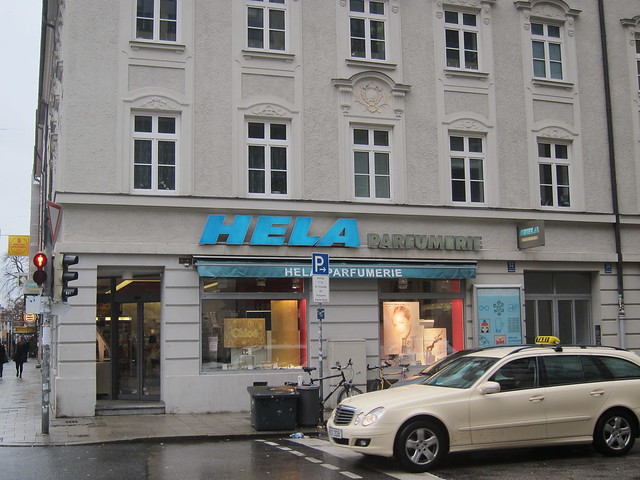
Or these 1970s inspired ads for a German cola brand AfriCola. A little sweeter than regular Coke, but with almost two-and-a-half times the caffeine, who can complain? (Except for Franz and Sara who were in the car with me for over an hour after I had one...)
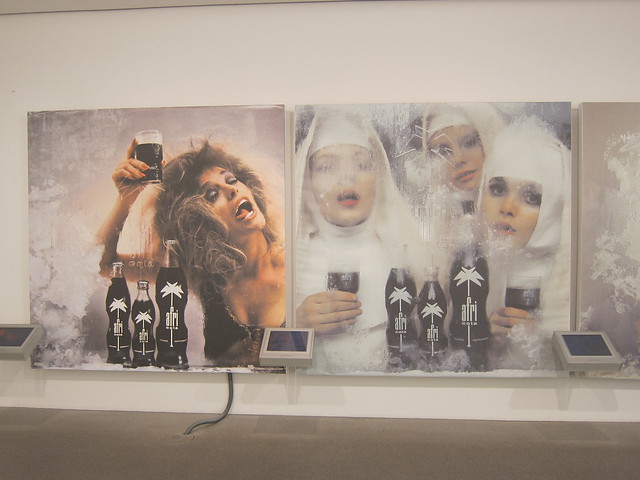
After our sledding excursion on Saturday (which was so special that it merits a separate post), Franz and Doro took us around the city on Sunday. We saw the beautiful tower of the Rathaus (city hall, for those who have forgotten), pictured here.

Since its construction in 1908, the Glockenspiel on the tower has delighted audiences at least daily with a 12-15 minute mechanical dance/presentation the represents two stories from the 16th century. First (on the top deck) is a depiction of Duke Wilhelm V's marriage to Renata of Lorraine (1568). There is a life-sized jousting match in honor of the newlyweds, pitting Bavaria against Lothringen. Guess who wins?
The bottom deck shows the Schäfflerstanz (the coopers' dance). From Wikipedia:
According to myth, 1517 was a year of plague in Munich. The coopers are said to have danced through the streets to "bring fresh vitality to fearful dispositions." The coopers remained loyal to the duke and their dance came to symbolize perseverance and loyalty to authority through difficult times. By tradition, the dance is performed in Munich every seven years. This was described in 1700 as "an age-old custom," but the current dance was defined only in 1871. The dance can be seen during Fasching (German Carnival): the next one is in 2012.Did you catch that? 2012? This year? Want to come see the Glockenspiel?

We have some short movies of the Rathausglockenspiel in action here and here.
Munich was an astoundingly beautiful city. There were abundant stair-stepped roofs:

Those roofs were even more apparent from the aerial view afforded by Alter Peter's church tower:


Here you see tour guide Franz giving Sara a church-tower-by-church-tower description of the city, with Doro in the red hat offering backup.

I think this may be one of the best pictures I've ever taken: the Münchener Rathausturm (city hall tower in Munich) in front of the red-roofed cityscape. The yellow church in the middle of the picture is the Theatine Church, built in the late 17th century in a beautiful high-Baroque style with a facade completed nearly 100 years later in a Rococo style. Both the outside and inside of this church were amazing.

A highlight of any visit to Munich (apparently) includes a trip to one of the Brauhäuser, the brewery-houses that dot the city. Franz and Doro took us to the Hofbräuhaus, a state-owned (!) brewery founded by our very own and recently married Duke Wilhelm V (1568). These brewery-houses are really cool: they have huge open areas with tables for people to gather, dance, sing, play music, play cards (and possibly other games). Some tables occasionally get reserved for community groups, and all tables get covered in beer. Hofbräuhaus has a section in the front for the Steine (giant beer mugs) for all of the famous people in Munich. If you're a mayor or other dignitary, you get your own Stein-storage locker at the Haus. Sara, Franz, and Doro have already picked out their spots (there weren't many empty ones left).

At the Hofbräuhaus, Sara and I both got one of our very favorite German foods: Käsespätzle. I won't describe it in too much detail here (since we don't have any trips planned and we need to save material for future blog posts), but it's like macaroni and cheese with extra deliciousness. And crispy onions. It's amazing. Also, I had my second non-alcoholic beer in a month! After reading my vivid description of my last near-beer experience, you're probably wondering why? Basically, Bavaria is the home of good beer, Franz knows good food, and after I told him that I had a near-beer in Köln, he told me that of course is tasted awful--it IS awful! Of course the WEIßbier is much better, even refreshing like a light, sparkling apple juice. Well, Franz, you are right. The Weißbier is MUCH better than the beer in Köln, no questions. Perhaps even a hint of sparkling apple juice is detectable. However, it's still just not that good. So, after two near-beers from the land of beer, I can conclusively say that I just don't like non-alcoholic beer. And, not drinking the other variety, beer just isn't going to play a role in my life. But I had the experience. Twice. Which was exactly two time more than I really needed, I suppose.
Another must-see in Munich, which we saw on Monday, is the Residenz, the former royal palace of Bavarian monarchs (construction begun in 1385, actively used as a palace from 1508, and converted to a public museum in 1918). Don't let the name "Residenz" fool you: this wasn't just a regular place for living, this is the largest castle-palace-museum-treasury conglomeration I've ever seen. It was labyrinthine and gargantuan and awesome. We started in the Schatzkammer (treasury) for some really gorgeous relics, and we'd now like to present a few exhibits, including this small selection of royal crowns:

(The pearly one is for Julia.)
Next, we have a travel kit of Marie Louise of Austria, the second wife of Napoleon. It includes service for four, travel toiletries, writing and seeing kits, several secret compartments, a measuring rod, a screwdriver, and implements for basic dental work.

Not in the treasury, this room in the Residenz palace appears to be decorated entirely in seashells.

These three final photos show some of the more breathtaking rooms of the Residenz. The first is the largest Renaissance interior north of the Alps, an room for antiques belonging to Duke Albrecht V. It is 66 meters (over 216 feet) long and full of elaborate busts and paintings.

Next is the private chapel of Duke Maximilian I, the Ornate Chapel. The title says it all. (The photo captures some of the ceiling and the porcelain cabinet on one of the walls.)

Lastly, a room for the family history aficionados, the Ancestral Gallery, full of over 100 portraits of members of the Wittelsbach family. Apparently, Karl Albrecht (in 1726) was hoping to curry favor with important people by demonstrating how well connected his family, and consequently he, had become by marriage. His plan worked: in 1742 in Frankfurt he was crowned Emperor Karl VII of the Holy Roman Empire. Do your family history, kids.

Munich is a beautiful city, one that we hope to revisit soon. (I anticipate that at least I will be coming back to do the measurements that were so abruptly taken from me.) Franz, Doro, you will forever be on the list of awesome friends/tour guides that make living in and traveling around Europe a wonderful experience. Noch mal, dankeschön!
P.S. A few funny things deserved photographs. Like this shout-out to our friends in Northern California.

Or these 1970s inspired ads for a German cola brand AfriCola. A little sweeter than regular Coke, but with almost two-and-a-half times the caffeine, who can complain? (Except for Franz and Sara who were in the car with me for over an hour after I had one...)

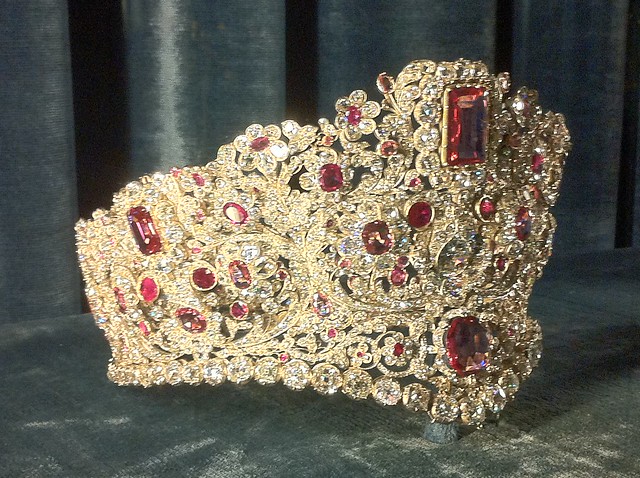
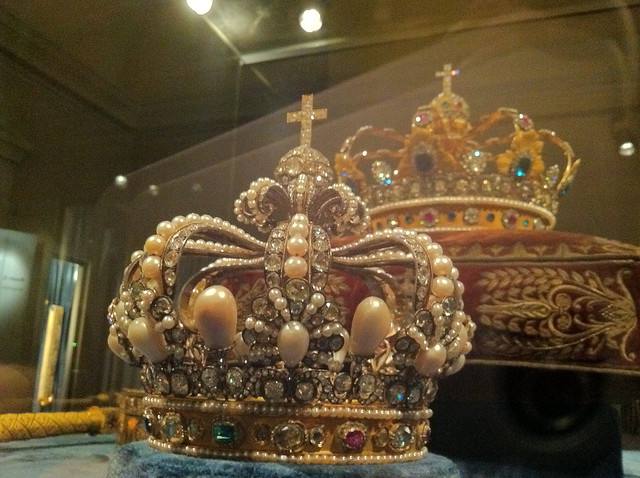
No comments:
Post a Comment
Comments remind us that once upon a time we had friends.